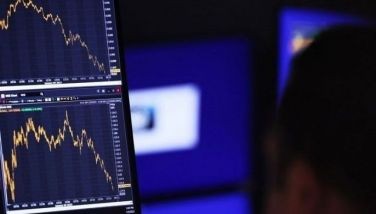Was there a ‘fire’ or not at UCPB?
July 1, 2003 | 12:00am
At the Bangko Sentral ng Pilipinas (BSP), the most dreaded telephone call that any governor could ever receive is the one that says, simply: "Sir, may sunog ako (I have a fire)."
A bank-run, like fire, could occur for no readily apparent reason and fast, usually taking less than a week, three days at the longest, before the BSP has to be brought into the scene to stop it.
Since January, the United Coconut Planters Bank (UCPB), once one of the biggest banks in the country, has been rumored to have gone through a number of outbreaks although none was big enough to be officially undeniable.
Sometime in April, UCPB asked for and received a P5-billion "advance" from the Philippine Deposit Insurance Co. (PDIC), the banking industry’s lender of last resort.
At around this time, news came out that UCPB emerged with the weakest capital base in the entire commercial banking industry, as its capital ratio continued to decline in 2002.
Data from the Bangko Sentral ng Pilipinas (BSP) showed that UCPB’s total equity as a percentage of its total assets declined to 2.89 percent as of its Dec. 17, 2002 statement of condition.
The capital ratio is a measure of a bank’s capital base and indicates its ability to absorb large-scale loan defaults and radical declines in its asset price.
The BSP explained that the capital ratio "broadly approximates" UCPB’s capital adequacy ratio (CAR) which measures the bank’s equity as a percentage of its risk assets.
Under the BSP rules, banks are required to maintain a minimum of 10-percent capital adequacy ratio to ensure that their pockets are deep enough to survive even the worst-case scenario.
"Definitely, they are below the central bank’s minimum prescribed CAR level," said a BSP official.
At the end of 2002, UCPB was capitalized at only P2.85 billion which was used to support total assets of P98.6 billion.
"This is the lowest among commercial banks except for Al-Amanah (Islamic Bank) which has negative capital," the official added.
UCPB’s latest capital ratio showed a decline from the 3.4-percent capital ratio it reported at the end of the third quarter. Its fourth quarter capital base, on the other hand, declined from the end-September level of P3.62 billion.
By the end of 2002, UCPB’s capital is half of its P5.78 billion in the previous year.
It has been long known that the UCPB was in dire need of fresh capital and has been unable to get any because no one is willing to invest in a bank whose ownership is still in question.
The "advance" from the PDIC was supposed to be part of a P20-billion financial assistance package that would recapitalize the bank and hopefully bring it back to its feet.
Why the PDIC? Why not the BSP, which is also mandated to extend emergency loans to banks facing temporary liquidity problems? Did it have a bank-run?
According to a BSP source, there is no clear definition for a bank-run or, if there are parameters to be followed, they are extremely flexible and even subjective.
"If a bank continues to lose deposits fast enough, then we can say it’s experiencing a run," the source explained. "But it’s a very relative thing, sometimes it becomes judgemental."
According to another source, the BSP’s rule of thumb is this: If the bank continues to use up its liquidity reserves, its primary and secondary reserves, then it is suspect.
The BSP finds this out immediately since banks are required to clear their daily transactions. "If they keep coming up with deficiencies in their reserves, they have a problem," the source said.
At this point, the source said the BSP makes a determination whether the bank is merely illiquid or insolvent altogether.
"It is not easy to determine if the bank is insolvent," the source said. "We have to determine if it is solvent based on the realizable value of its assets, not just its total assets."
The source explained that, unlike the central bank, whose mandate is to provide temporary liquidity when needed, the PDIC is actually the lender of last resort.
Under Section 12 of the PDIC’s charter, the corporation is mandated to purchase assets or assume the liabilities of or to make deposits to a bank if it determines that the bank is "in danger of closing."
In contrast, the BSP only steps in if the bank is facing "temporary liquidity problems", the source said. Under the General Banking Law, the source said an ailing bank would go to the BSP for assistance if it is illiquid. The assistance that the BSP is allowed to extend "shall not exceed 50 percent of total deposits and deposit substitutes."
"If a bank is near-collapse and wants to be rehabilitated, it goes to the PDIC," said the source.
A bank-run, like fire, could occur for no readily apparent reason and fast, usually taking less than a week, three days at the longest, before the BSP has to be brought into the scene to stop it.
Since January, the United Coconut Planters Bank (UCPB), once one of the biggest banks in the country, has been rumored to have gone through a number of outbreaks although none was big enough to be officially undeniable.
Sometime in April, UCPB asked for and received a P5-billion "advance" from the Philippine Deposit Insurance Co. (PDIC), the banking industry’s lender of last resort.
At around this time, news came out that UCPB emerged with the weakest capital base in the entire commercial banking industry, as its capital ratio continued to decline in 2002.
Data from the Bangko Sentral ng Pilipinas (BSP) showed that UCPB’s total equity as a percentage of its total assets declined to 2.89 percent as of its Dec. 17, 2002 statement of condition.
The capital ratio is a measure of a bank’s capital base and indicates its ability to absorb large-scale loan defaults and radical declines in its asset price.
The BSP explained that the capital ratio "broadly approximates" UCPB’s capital adequacy ratio (CAR) which measures the bank’s equity as a percentage of its risk assets.
Under the BSP rules, banks are required to maintain a minimum of 10-percent capital adequacy ratio to ensure that their pockets are deep enough to survive even the worst-case scenario.
"Definitely, they are below the central bank’s minimum prescribed CAR level," said a BSP official.
At the end of 2002, UCPB was capitalized at only P2.85 billion which was used to support total assets of P98.6 billion.
"This is the lowest among commercial banks except for Al-Amanah (Islamic Bank) which has negative capital," the official added.
UCPB’s latest capital ratio showed a decline from the 3.4-percent capital ratio it reported at the end of the third quarter. Its fourth quarter capital base, on the other hand, declined from the end-September level of P3.62 billion.
By the end of 2002, UCPB’s capital is half of its P5.78 billion in the previous year.
It has been long known that the UCPB was in dire need of fresh capital and has been unable to get any because no one is willing to invest in a bank whose ownership is still in question.
The "advance" from the PDIC was supposed to be part of a P20-billion financial assistance package that would recapitalize the bank and hopefully bring it back to its feet.
Why the PDIC? Why not the BSP, which is also mandated to extend emergency loans to banks facing temporary liquidity problems? Did it have a bank-run?
According to a BSP source, there is no clear definition for a bank-run or, if there are parameters to be followed, they are extremely flexible and even subjective.
"If a bank continues to lose deposits fast enough, then we can say it’s experiencing a run," the source explained. "But it’s a very relative thing, sometimes it becomes judgemental."
According to another source, the BSP’s rule of thumb is this: If the bank continues to use up its liquidity reserves, its primary and secondary reserves, then it is suspect.
The BSP finds this out immediately since banks are required to clear their daily transactions. "If they keep coming up with deficiencies in their reserves, they have a problem," the source said.
At this point, the source said the BSP makes a determination whether the bank is merely illiquid or insolvent altogether.
"It is not easy to determine if the bank is insolvent," the source said. "We have to determine if it is solvent based on the realizable value of its assets, not just its total assets."
The source explained that, unlike the central bank, whose mandate is to provide temporary liquidity when needed, the PDIC is actually the lender of last resort.
Under Section 12 of the PDIC’s charter, the corporation is mandated to purchase assets or assume the liabilities of or to make deposits to a bank if it determines that the bank is "in danger of closing."
In contrast, the BSP only steps in if the bank is facing "temporary liquidity problems", the source said. Under the General Banking Law, the source said an ailing bank would go to the BSP for assistance if it is illiquid. The assistance that the BSP is allowed to extend "shall not exceed 50 percent of total deposits and deposit substitutes."
"If a bank is near-collapse and wants to be rehabilitated, it goes to the PDIC," said the source.
BrandSpace Articles
<
>
- Latest
- Trending
Trending
Latest
Trending
Latest
Recommended




























